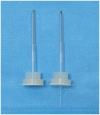Effects and mechanisms of acupuncture for PIGD-subtype Parkinson's disease via integration of fMRI and gut microbiota-metabolomics analysis: protocol for a prospective randomized controlled trial
- PMID: 40433511
- PMCID: PMC12106412
- DOI: 10.3389/fnagi.2025.1534165
Effects and mechanisms of acupuncture for PIGD-subtype Parkinson's disease via integration of fMRI and gut microbiota-metabolomics analysis: protocol for a prospective randomized controlled trial
Abstract
Introduction: Parkinson's disease (PD) can be categorized into various subtypes based on the primary symptoms associated with motor dysfunction. One subtype, known as postural instability and gait difficulty (PIGD), is characterized by severe clinical symptoms, an increased risk of walking difficulties and falls, and a poorer prognosis compared to other subtypes. This condition imposes a significant burden on patients, their families, and the healthcare system. Recently, acupuncture, a practice rooted in traditional Chinese medicine, has gained attention for its potential to influence neurophysiological pathways and enhance the overall brain function in individuals with PD. This randomized controlled study aimed to evaluate the clinical effectiveness of acupuncture in patients with the PIGD subtype of PD and to investigate the preliminary exploration of mechanisms of acupuncture by analyzing intestinal microbiota and metabolomics, thereby providing deeper insights into its impact on patients.
Methods: This randomized controlled trial will involve 64 patients diagnosed with the PIGD subtype of PD. Participants in both groups will undergo three acupuncture sessions weekly for a duration of 4 weeks, followed by an 8-week follow-up period. The primary outcome measure will be the Unified Parkinson's Disease Rating Scale III. Secondary outcomes will include the Berg Balance Scale (BBS), wearable gait analysis, and functional magnetic resonance imaging (fMRI). Additionally, serum and stool samples will be collected for 16S ribosomal RNA sequencing, and liquid chromatography coupled with tandem mass spectrometry analysis (LC-MS/MS) will be employed to elucidate theunderlying mechanisms. This trial has been reviewed and approved by the Medical Ethics Committee of Zhejiang Hospital (Approval no. 2023-15 K). Participation in this study will require written informed consent from all patients. The findings of this study will be published in a peer-reviewed journal, and there will be no restrictions on publication.
Discussion: In this study, we integrate traditional assessment scales with fMRI to demonstrate the therapeutic effects of acupuncture. We will also analyze the modulation of gut microbiota and serum metabolome to explore the underlying neural mechanisms. Our results will provide a foundation for future studies in this area.
Clinical trial registration: https://www.chictr.org.cn, identifier ChiCTR2300071703.
Keywords: Parkinson’s disease; acupuncture; fMRI; intestinal flora; metabolomics; protocol; randomized controlled trial.
Copyright © 2025 Sheng, Xu, Liu, Zhu, Mu, Zhai, Xu, Wang, Liu, Liu and Jin.
Conflict of interest statement
The authors declare that the research was conducted in the absence of any commercial or financial relationships that could be construed as a potential conflict of interest.
Figures



Similar articles
-
Acupuncture for early Parkinson's disease with mild to moderate depression: a randomized controlled trial protocol with functional MRI.Front Neurol. 2024 Oct 4;15:1457787. doi: 10.3389/fneur.2024.1457787. eCollection 2024. Front Neurol. 2024. PMID: 39430584 Free PMC article.
-
Efficacy of acupuncture (Jin's three-needle) on motor symptoms and anxiety in patients with Parkinson's disease: protocol for a multicentre, randomised, assessor-blinded clinical trial.BMJ Open. 2024 Mar 28;14(3):e081312. doi: 10.1136/bmjopen-2023-081312. BMJ Open. 2024. PMID: 38548359 Free PMC article.
-
Acupuncture treatment of restless legs syndrome: a randomized clinical controlled study protocol based on PET-CT and fMRI.Front Psychiatry. 2024 Dec 24;15:1481167. doi: 10.3389/fpsyt.2024.1481167. eCollection 2024. Front Psychiatry. 2024. PMID: 39822388 Free PMC article.
-
Folic acid supplementation and malaria susceptibility and severity among people taking antifolate antimalarial drugs in endemic areas.Cochrane Database Syst Rev. 2022 Feb 1;2(2022):CD014217. doi: 10.1002/14651858.CD014217. Cochrane Database Syst Rev. 2022. PMID: 36321557 Free PMC article.
-
Efficacy of acupuncture in ameliorating anxiety in Parkinson's disease: a systematic review and meta-analysis with trial sequential analysis.Front Aging Neurosci. 2024 Nov 11;16:1462851. doi: 10.3389/fnagi.2024.1462851. eCollection 2024. Front Aging Neurosci. 2024. PMID: 39588511 Free PMC article.
References
-
- Ahrweiller K., Houvenaghel J. F., Riou A., Drapier S., Sauleau P., Haegelen C., et al. . (2019). Postural instability and gait disorders after subthalamic nucleus deep brain stimulation in Parkinson’s disease: A PET study. J. Neurol. 266, 2764–2771. doi: 10.1007/s00415-019-09482-y, PMID: - DOI - PubMed
-
- Demonceau M., Donneau A.-F., Croisier J.-L., Skawiniak E., Boutaayamou M., Maquet D., et al. . (2015). Contribution of a trunk accelerometer system to the characterization of gait in patients with mild-to-moderate Parkinson’s disease. IEEE J. Biomed. Health Inform. 19, 1803–1808. doi: 10.1109/JBHI.2015.2469540, PMID: - DOI - PubMed
LinkOut - more resources
Full Text Sources

